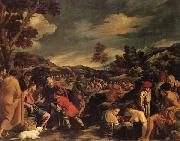Wholesale Oil Painting No Minimum |
|||||||||||
|
|
|||||||||||

|
|||||||||||
|
|
|
||||||||
ORRENTE, PedroSpanish Baroque Era Painter, 1580-1645 Spanish painter. He is one of the most interesting artists of his day. His father, Jaime Orrente, was a merchant from Marseille, his mother, Isabel Jumilla, from Murcia. By 1600 Orrente was active in Toledo, where he was commissioned to paint a retable (untraced). In 1607 and again in 1611 he was in Murcia, and a journey to Italy recorded by Jusepe Mart?nez and Palomino must have taken place between those years. It seems certain that he visited Venice and met Leandro Bassano |
||||||||
|
|
||||||||
The Miracle of the Loaves and Fishes
The Miracle of the Loaves and Fishes Painting ID:: 29162 |
mk65
Oil on canvas
42x53 1/2"
mk65 Oil on canvas 42x53 1/2" |
|||||||
|
|
||||||||
|
Tintoretto Italian Mannerist Painter, ca.1518-1594 His father was a silk dyer (tintore); hence the nickname Tintoretto ("Little Dyer"). His early influences include Michelangelo and Titian. In Christ and the Adulteress (c. 1545) figures are set in vast spaces in fanciful perspectives, in distinctly Mannerist style. In 1548 he became the centre of attention of artists and literary men in Venice with his St. Mark Freeing the Slave, so rich in structural elements of post-Michelangelo Roman art that it is surprising to learn that he had never visited Rome. By 1555 he was a famous and sought-after painter, with a style marked by quickness of execution, great vivacity of colour, a predilection for variegated perspective, and a dynamic conception of space. In his most important undertaking, the decoration of Venice's Scuola Grande di San Rocco (1564 C 88), he exhibited his passionate style and profound religious faith. His technique and vision were wholly personal and constantly evolving. The Miracle of the Loaves and Fishes 1578-81 Oil on canvas, 523 x 460 cm |
||||||||
|
|
||||||||
|
Prev Next
|
||||||||
|
|
||||||||
|
Related Paintings to Tintoretto :. |
||||||||
|
|
||||||||
|
CONTACT US |

